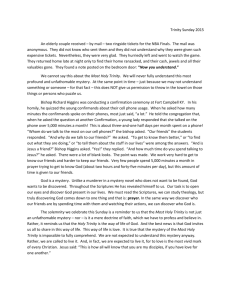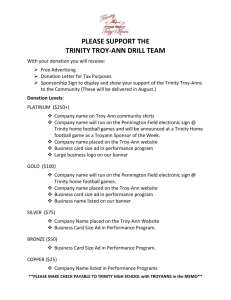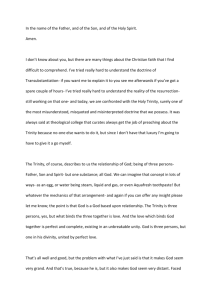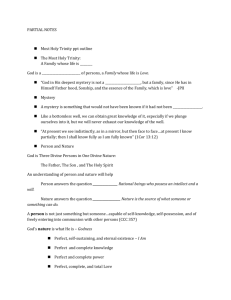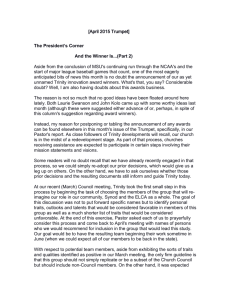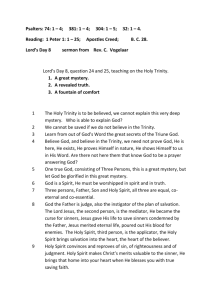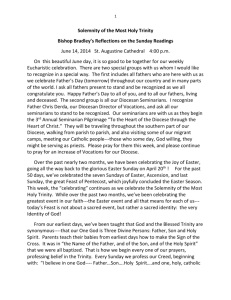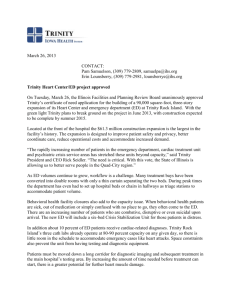2013.09.08 ITC Trinity
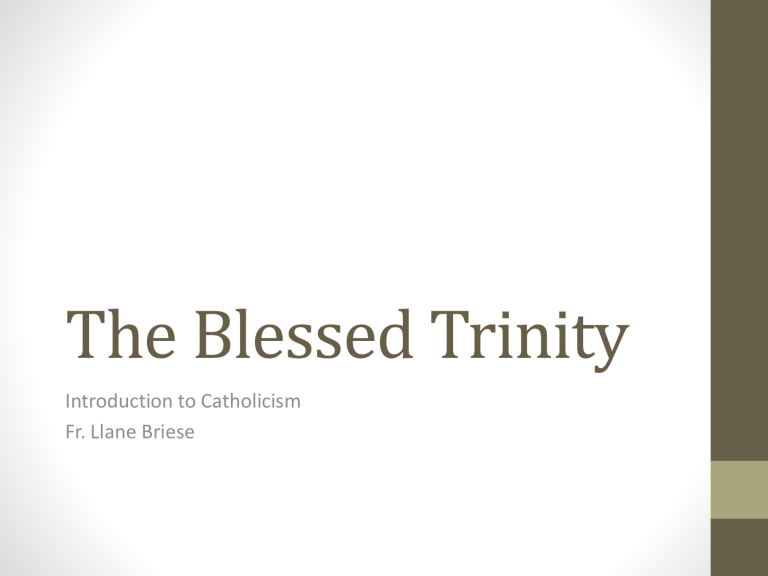
The Blessed Trinity
Introduction to Catholicism
Fr. Llane Briese
Key Terms/Concepts
• Monotheism
• Shema
• “I AM”
• OT Attributes of God
(truth, wisdom, everlasting love)
• Jesus’ Divinity in the NT
• Mystery
• Heresy
• Adoptionism
• Modal Monarchianism
• Arianism
• Ecumenical Council
• Dogma
• Substance (ousia)
• Consubstantial
(homoousios)
• Person (hypostasis)
• Relation
Lesson One
THE BIBLICAL WITNESS
The Biblical Witness: OT
• Israel was unlike any other nation by subscribing to monotheism, the belief in only one God.
• The Shema, still fundamental to Jews and
Christians alike:
• Deuteronomy 6:4-5: Hear, O Israel! The
LORD is our God, the LORD alone!
Therefore, you shall love the LORD, your
God, with your whole heart, and with your whole being, and with your whole strength.”
The Biblical Witness: OT
• Exodus 3:14: “ God replied to Moses: I am who I am. Then he added: This is what you will tell the Israelites: I AM has sent me to you.
• OT Attributes of the One God:
• Truth (ᵓĕmet; cf. Ps 115:1)
• Wisdom (hokmah; cf. Prov 8; Sir 24)
• Everlasting Love (ḥesed; cf. Ps 118, 136)
The Biblical Witness: OT
• One key verse that has received much attention in Christian history:
• Genesis 1:26: Then God said: Let us make human beings in our image, after our likeness.
Let them have dominion over the fish of the sea, the birds of the air, the tame animals, all the wild animals, and all the creatures that crawl on the earth.
• This is likely a sensus plenior (a fuller sense) of the text in which God’s intention exceeds that understood by the human author.
The Biblical Witness: NT
• The Divinity of Christ
• John 1:1, 14: “In the beginning was the Word, and the Word was with God, and the Word was God. […] And the Word became flesh and made his dwelling among us, and we saw his glory, the glory as of the Father's only Son, full of grace and truth.”
• Matthew 11:27: “All things have been handed over to me by my Father. No one knows the
Son except the Father, and no one knows the
Father except the Son and anyone to whom the Son wishes to reveal him.”
The Biblical Witness: NT
• CCC 240: “Jesus revealed that God is Father in an unheard of sense: he is Father not only in being Creator; he is eternally Father in relation to the Son, who is eternally Son only in relation to his Father […]”
• Matthew 28:19: “Go, therefore, and make disciples of all nations, baptizing them in the name of the Father, and of the Son, and of the holy Spirit […]”
• John 20:28: “Thomas answered and said to him, "My Lord and my God!”
Lesson Two
HISTORICAL DEVELOPMENT
The First Few Centuries
• Until 313, Christianity was persecuted.
• Therefore, discussion occurred quietly:
• St. Clement of Rome, St. Ignatius of Antioch
(late 1 st century/early 2 nd ) spoke of Christ as
“our God” and the Spirit as speaking through the prophets.
• The Apologists (esp. St. Justin) also spoke of
Jesus as the logos (“word”/“reason”) in the
2 nd century.
Excursus: Language about God
• A mystery is something about which we can say something correct, but not everything.
• God is an ineffable mystery, a truth which words can never fully describe.
• Hence, when we speak about the Trinity (or many other truths of the Faith), we can only speak in analogies, we can never describe
God fully.
• Example: Filling a water bottle with the
Atlantic Ocean.
Crisis of Faith: 3 Major Heresies
• Central Question: How do Christians believe both in only one God, but also believe that Jesus is truly divine?
• As with all theology, the task was to be true to the faith while articulating it in an intellectually satisfying manner.
• Heresy: A failed attempt to articulate the mystery due to a lack to faithfulness to
Revelation.
Crisis of Faith: 3 Major Heresies
• Adoptionism (e.g. Paul of Samosata, condemned in 286 A.D.)
• Modal Monarchianism (e.g. Noetus of
Smyrna, Sabellius, 2 nd and 3 rd centuries)
• Arianism (began with the priest Arius of
Alexandria in 319 A.D., began a major crisis)—the most famous version of subordinationism: “There once was a time when the Son was not.”
Council of Nicaea I (325 A.D.)
• Called by the Emperor Constantine in June
325 in the northwest corner of Asia Minor.
• 1 st Ecumenical Council
• Defined a Dogma:
• The Son is consubstantial (homoousios) with the Father.
• Literally, “of the same substance”
• Defended vigorously by St. Athanasius
(bishop of Alexandria from 328-373, exiled five times).
Council of Constantinople I
(381 A.D.)
• Arianism was a continual problem throughout the 4 th century. (It didn’t help that Constantine’s son, Constantius, favored Arianism.)
• Meanwhile, St. Athanasius and the three
Cappadocian Fathers (St. Basil the Great,
St. Gregory of Nanzianzus, and St. Gregory of Nyssa) contributed greatly.
• In 381, another council was held.
Niceno-Constantinopolitan Creed
• The Creed recited in class and at Mass identical as that of Constantinople I in 381 (except for the
Filioque).
• Major Affirmations:
• Full divinity of the Father, Son, and Holy Spirit
(homoousios = consubstantial = same substance).
• Real distinction between the three. (Three
hypostases = Persons)
• The names Father, Son, and Holy Spirit are
relations which describe each person in distinction to each other. (cf. St. Gregory of
Nanzianzus, “Third Theological Oration”)
Key Points of Trinitarian Dogma
• Tradition in action: The Church says “in other words” when interpreting Scripture, borrowing language from Greek philosophy.
• Key affirmations:
• God is one. The Trinity is one God.
• The Persons are truly distinct.
• The Persons are relative to each other.
Later Controversy: Filioque
• Due largely to the influences of two different schools of thought, the East and West have one major difference in the Creed: the Filioque
(Latin: “and the Son”)
• Pope St. Leo I: Confessed it in 447 even before the Roman Church received the creed of
Constantinople I.
• Filioque is true because Son shares with the
Father everything except being Father.
• East: Spirit comes from the Father, and through the Son.
• Main Point: 2 orthodox ways of articulating the mystery.
Lesson Three
WHY IS THIS IMPORTANT?
Immanent vs. Economic Trinity
• Based in a traditional distinction between theology and economy, we can distinguish between:
• The Immanent Trinity: The inner life of the
Three distinct but united Persons.
• The Economic Trinity: The life of the Trinity as manifested in human history (i.e. through Revelation).
The Trinity as Mystery
• CCC 237: “The Trinity is a mystery of faith in the strict sense, one of the ‘mysteries that are hidden in God, which can never be known unless they are revealed by God.’ To be sure, God has left traces of his Trinitarian being in his work of creation and in his Revelation throughout the
Old Testament. But his inmost Being as Holy
Trinity is a mystery that is inaccessible to reason alone or even to Israel’s faith before the
Incarnation of God’s Son and the sending of the
Holy Spirit.”
The Trinity as Our Future Glory
• All of humanity is about entering into communion with the Most Blessed Trinity.
• Just as Christ (God the Son) entered into solidarity with the human race, and the
Spirit dwells within us, so we are called to be fully conformed to the Triune God.
